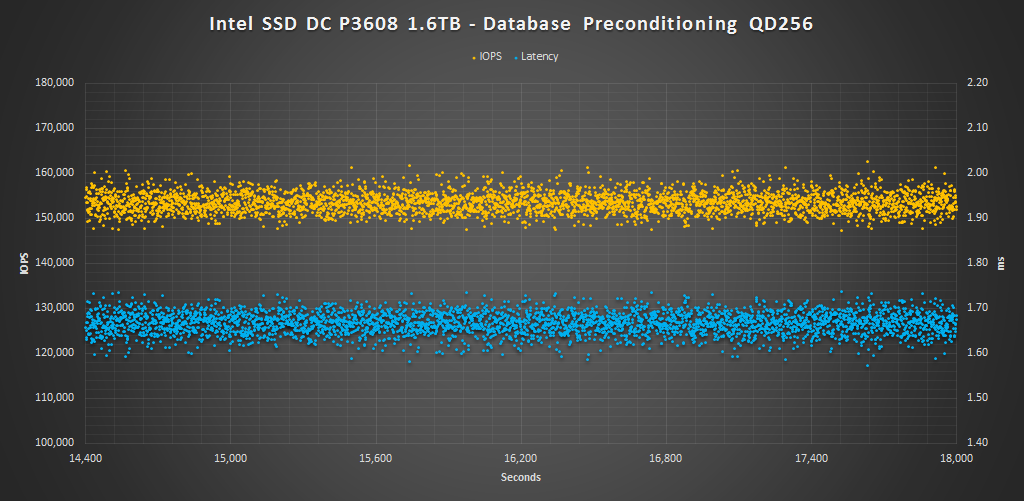SERVER PROFILES
While synthetic 100% read or 100% write workloads do a great job of testing the underlying technology and reporting easy to understand results, they aren’t always indicative of how the drive will be used by the end user. Workloads that simulate enterprise environments try to bridge that gap without being overly complex. The process of measuring our server workload performance is the same as measuring random. The drive is first secure erased to get it in a clean state. Next, the drive is filled by sequentially writing to the RAW NAND capacity twice. We then precondition the drive with respective server workload at QD256 until the drive is in a steady state. Finally, we cycle through QD1-256 for 5 minutes each measuring performance. All this is scripted to run with no breaks in between. The last hour of RAID 0 preconditioning, the average IOPS, and average latency for each QD is graphed below.
The Database profile is 8K transfers, and 67% percent of operations are reads.
In RAID 0, during the Database benchmark latency stayed below 1.75ms on average and peaked out at 155K IOPS. If you look back to our review of the Intel DC P3700, while it isn’t the same system and our methodology changed a bit since then, during the database benchmark that it has a bit of an advantage at lower QDs until QD64. So depending on your specific application QD workload, the DC P3700 may be a bit of a better option from Intel in terms of performance, let alone write endurance.
The Email Server profile is similar to the Database profile, only it 8K transfers at 50% reads and 50% writes.
During the Email Server benchmark high QD IOPS averages were the highest we have seen from a single drive SSD. Latency was pretty well controlled until QD 128, after that it jumps from about 1ms to just over 2ms. IOPS consistency and latency was very good at QD256 as well. IOPS ranged around 10K and latency ranged 0.1ms.
 The SSD Review The Worlds Dedicated SSD Education and Review Resource |
The SSD Review The Worlds Dedicated SSD Education and Review Resource | 


Random adjectives, desperate efforts to “humanize” the tech resulted in this huge review to contain next to no information at all.
There is no easy way to say this: software RAID 0 on PCIe is simply retarded.
Thanks for your thoughts
Now just make it affordable
Well, for enterprise it is very affordable for what you get. If you are concerned about consumers/enthusiasts I can see where you are coming from, but this is not meant for them. Next year, however, we may be seeing performance like this trickle down.
More than likely next year
As an enterprise product I can see it as a high-end workstation device but not a server device. The lack of RAIDability seems to limit its use to caching and high-speed scratch work area.
I’ve been informed that PCIe hardware RAID will be available on the Skylake CPU and the Xeon version when it comes out later. Now we’re talking………
so this is a preview, not a review… where are the comparisons to P3700 and PM951?
I don’t have access to those drives. We reviewed the P3700 in another system. Because of that as well as a change in our testing methodology, we cant not graph them side by side. Looking at the P3700’s specific review you can gauge for yourself the approximate performance difference between the two.